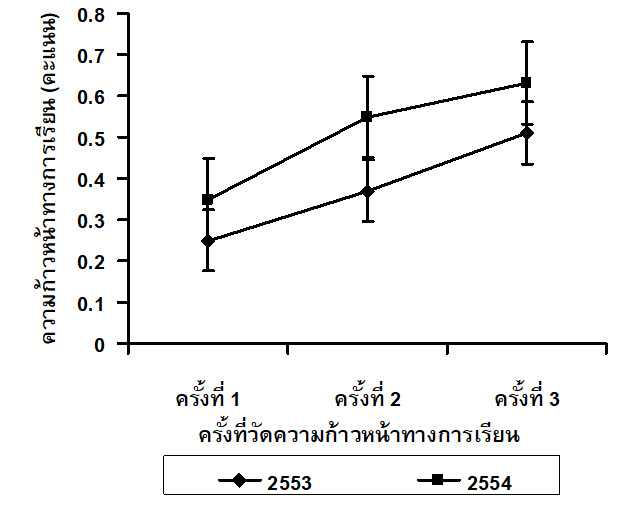การพัฒนาการเรียนการสอนวิชาชีวสถิติในระดับปริญญาตรีด้วยการสอนแบบสร้างความรู้ด้วยตนเอง
Main Article Content
Abstract
Somkiat Phornphisutthimas
รับบทความ: 3 ตุลาคม 2554; ยอมรับตีพิมพ์: 2 ธันวาคม 2554
บทคัดย่อ
ชีวสถิติเป็นวิชาที่มีเนื้อหาค่อนข้างยากและต้องใช้เนื้อหาการทดลองที่เกี่ยวข้องมาประกอบ งานวิจัยนี้มีจุดประสงค์เพื่อปรับปรุงการจัดการเรียนการสอนรายวิชาชีวสถิติโดยเพิ่มแบบฝึกปฏิบัติที่ใกล้เคียงกับสาขาวิชาที่ผู้เรียนมาลงทะเบียน ให้ผู้เรียนได้ร่วมกิจกรรมทั้งในและนอกห้องเรียน และสอนแบบให้ผู้เรียนสร้างความรู้ด้วยตนเอง ผลการศึกษา พบว่า ผู้เรียนที่ลงทะเบียนเรียนในปีการศึกษา 2553 จำนวน 46 คน มีคะแนนสอบก่อนเรียนโดยเฉลี่ยเท่ากับ 2.96 ± 1.57 คะแนน (จากคะแนนเต็ม 10 คะแนน) และมีค่าเฉลี่ยของความก้าวหน้าทางการเรียนเพิ่มขึ้นในการวัดผล 3 ครั้ง เท่ากับ 0.25 ± 0.24, 0.37 ± 0.23 และ 0.51± 0.36 ตามลำดับ ส่วนในปีการศึกษา 2554 ผู้เรียนที่ลงทะเบียน จำนวน 65 คน มีคะแนนสอบก่อนเรียนโดยเฉลี่ยเท่ากับ 2.10 ± 0.87 คะแนน (จากคะแนนเต็ม 10 คะแนน) และมีค่าเฉลี่ยของความก้าวหน้าทางการเรียนเพิ่มขึ้นในการวัดผล 3 ครั้ง เท่ากับ 0.35 ± 0.24, 0.55 ± 0.23 และ 0.63 ± 0.20 ตามลำดับ เมื่อเปรียบเทียบความก้าวหน้าทางการเรียนของผู้เรียนทั้ง 2 ปีการ ศึกษา พบว่า ผู้เรียนในปีการศึกษา 2554 ซึ่งอยู่ในชั้นปีที่ 3 มีความก้าวหน้าทางการเรียนสูงกว่าผู้เรียนในปีการศึกษา 2553 ซึ่งอยู่ในชั้นปีที่ 2 (p < .05) และจำนวนผู้เรียนที่มีผลการเรียนในระดับต่ำน้อยลงและมีผู้เรียนถอนรายวิชาน้อยกว่าในปีการศึกษา 2550–2552 โดยผู้เรียนถอนรายวิชานี้มีสาเหตุมาจากประสบอุบัติเหตุและไม่เข้าเรียน สรุปได้ว่า การจัดการเรียนรู้รายวิชาชีวสถิติโดยการจัดการเรียนรู้แบบให้ผู้เรียนสร้างความรู้ด้วยตนเองช่วยให้ผู้เรียนมีความรู้ความเข้าใจในเนื้อหารายวิชาชีวสถิติมากขึ้น
คำสำคัญ: ชีวสถิติ รูปแบบการเรียนรู้โดยสร้างความรู้ด้วยตนเอง วิทยาศาสตร์ชีวภาพ ระดับปริญญาตรี
Abstract
Biostatistics is a high difficult subject including the practicals. This research aimed to improve the learning and teaching management by increasing practices containing the contents corresponding to the field of registered learners’ studies, giving learners’ chances to participate both in and out of class, and teaching learners using constructivist learning model. The results showed that forty-six learners registered in academic year 2010 had the average pretest score of 2.96 ± 1.57 (of 10 in toto). The learners’ average gain progressions of three-times evaluation were orderly increased by 0.25 ± 0.24, 0.37 ± 0.23 and 0.51± 0.36. In the academic year 2011, sixty-five learners had the average pretest score of 2.10 ± 0.87 (of 10 in toto). The learners’ average gain progressions of evaluated three-times evaluation were orderly increased by 0.35 ± 0.24, 0.55 ± 0.23, and 0.63 ± 0.20. When comparing gain progressions between both years, the third-year learners registered in academic year 2011 had higher gain progressions than the second-year learners registered in academic year 2010 (p < .05). The numbers of learners who had the low-level achievement were decreased; moreover, the numbers of learners who had withdrawn this subject were less than those in academic year 2007–2009. The learners who had withdrawn in academic year 2010–2011 were an accidental case and not in attendance. In conclusion, the management of learning biostatistics using the constructivist learning model can assist learners to increase understanding of the biostatistics contents.
Keywords: Biostatistics, Constructivist learning model, Biological science, Undergraduate level
Downloads
Article Details

This work is licensed under a Creative Commons Attribution-NonCommercial 4.0 International License.
References
สมเกียรติ พรพิสุทธิมาศ. (2553). ชีวสถิติ. กรุงเทพฯ: ภาควิชาชีววิทยา คณะวิทยาศาสตร์ มหาวิทยาลัยศรีนครินทรวิโรฒ.
สมเกียรติ พรพิสุทธิมาศ. (2554). เอกสารประกอบการสอนวิชาชีวสถิติ เรื่อง “การวางแผนและวิเคราะห์ผลการทดลอง” (ฉบับปรับปรุง). กรุงเทพฯ: ภาควิชาชีววิทยา คณะวิทยาศาสตร์ มหาวิทยาลัยศรีนครินทรวิโรฒ.
Banks, S. W., Shepherd, D. K., Williams-Hart, T., Gossett, D. R., and Crnkovic, A. C. (2007). Snail shells in a practical application of statistical procedures. J. Biol. Educ. 41(3): 131–137.
deVries, R. (2002, October). What is constructivist about constructivist education? Keynote Address at the Annual Meeting of the Association for Constructivist Teaching, Houston, TX.
Driver, R., Asoko, H., Leach, J., Mortimer, E., and Scott, P. (1994). Constructing scientific knowledge in the classroom. Educ. Res. 23: 5-12.
Hake, R. R. (1998). Interactive-engagement versus traditional methods: A six-thousand-student survey of mechanics test data for introductory physics courses. Amer. J. Phys. 66: 64–74.
Khan, N., and Mumtaz, Y. (2009). Attitude of teaching faculty towards statistics at medical university in Karachi, Pakistan. J. Ayub Med. Coll. Abbottabad 21(3): 166–171.
Laloknam, S., Sirisopana, S., and Phornphisutthimas, S. (2010). Learning retention in undergraduate biology using a hands-on practical “Enzyme detection from vegetables and fruits”. J. Chem. Chem. Eng. 4(5): 29-35.
Lorowitz, W., Saxton, E., Sondossi, M., and Nakaoka, K. (2005). Integrating statistics with a micro-biology laboratory activity. J. Microbiol. Biol. Educ. 6: 14–19.
Partridge, N. (2003). Science out of the classroom. J. Biol. Educ. 37(2): 56–57.
Phornphisutthimas, S., Leepairotkun, K., Koben, J., Laloknam, S., Limchoowong, S., and Poopitaya-sataporn, K. (2008, October). Learning biomolecules through an online-learning lesson by constructivism at senior secondary and undergraduate levels. The 34th Congress on Science and Technology of Thailand. Queen Sirikit National Convention Center, Bangkok, Thailand.
Phornphisutthimas, S., Thamchaipenet, A., and Panijpan, B. (2007). Conjugation in Escherichia coli: A laboratory exercise. Biochem. Mol. Biol. Educ. 35(6): 440–445.
Prokop, P., Prokop, M., and Tunnicliffe, S. D. (2007). Is biology boring? Student attitudes toward biology. J. Biol. Educ. 42(1): 36–39.
Resnick, L. B. (1989). Introduction. In L. B. Resnick (Ed.), Knowing, learning, and instruction: Essays in honour of Robert Glaser (pp. 1–24). Hillsdale, NJ: Erbrum.
Sami, W. (2010). Biostatistics education for undergraduate medical students. Biomedica 26: 80–84.
Soler, J. P. (2006, July). Biostatistics teaching in the new genome era. The 7th International Conference on Teaching Statistics. Salvador, Bahia, Brazil.
Towns, M. H., Raker, J. R., Becker, N., and Sutcliffe, J. (2012). The biochemistry tetrahedron and the development of the taxonomy of biochemistry external representation (TOBER). Chem. Educ. Res. Prac. DOI: 10.1039/c2rp00014th
Vygotsky, L. S. (1978). Mind in Society: The develop-ment of higher psychological processes. Cambridge, MA: Harvard University Press.
